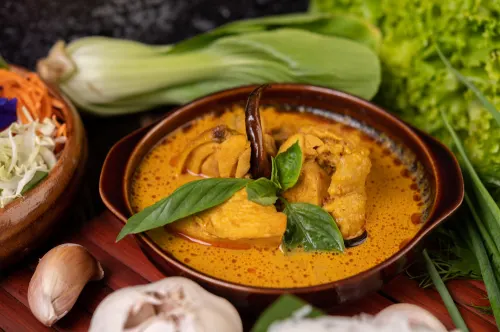Vegan, Vegetarian & Gluten-Free Indian Dishes
Some meals leave you choosing between flavour and restriction. Not here. Indian cuisine, rich in legumes, grains, and vegetables, was created to change. It’s not a genre that simulates its roots in flexibility. Whether it’s dairy-free curries with depth or gluten-free flatbreads that tear just right, there’s no loss of tradition, only reinterpretation. This is food that doesn’t whisper apologies for being “free from.” It holds its head high, simmering in turmeric, crackling in mustard seeds, offering joy in every spoonful without a single compromise to dietary choice.
Vegan Dishes That Lead with Flavour
The mystery is in what’s left in, not what’s taken out. Vegan Indian food honours ingredients for what they are: brave, spiced, and layered. Dishes like aloo baingan, with its smoky eggplant melt, or chana masala steamed in onion-tomato masala, are no reasons. Coconut cream adds velvet where dairy once stood. Curry leaves pop in hot oil, lending scent before taste. This is not cuisine built for substitutes; it is the blueprint. Vegan doesn’t need an announcement here. It blends into tradition, uninterrupted, powerful in its quiet assurance of flavour-first eating.
Vegetarian Meals with Real Presence
A vegetarian thali is never an afterthought; it’s the ceremony. Paneer cubes soaked in rich, spiced gravies, dry-spiced okra that bites back, dal slow-cooked to silk, it’s all intentional. Each portion plays a role. The meal is poised not only nutritionally but emotionally. One dish comforts, another excites. Some are cool, some are awaken. Whether for casual midweek dinners or celebratory weekend outings, vegetarian dishes arrive at the table confident in their role. They speak the language of home and feast at once. Not restricted. Not lacking. Just whole and entirely satisfying.
Gluten-Free from the Ground Up
Before it was a trend, it was already a practice. Much of Indian cuisine, from South Indian dosa to North Indian bajra rotis, naturally avoids gluten. No reformulation is necessary. Instead of adjusting, the dishes show themselves: idlis created from rice and lentil batter, fluffy and subtle; pakoras fried in chickpea flour, crispy without wheat’s interference. Actually, desserts, think rice-based kheer or coconut-laced laddoos, suit effortlessly. What’s amazing is how unremarkable the change feels. There’s no spotlight on the absence. Instead, attention stays on texture, warmth, and aroma, the reasons you came in the first place.
Dining Without Dietary Anxiety
There’s an unspoken comfort in reading a menu and knowing you belong. Clear labelling. Polite acknowledgment from staff. The ability to ask if something contains cream or flour without embarrassment. Whether you’re dining in or ordering online, that assurance matters. The food doesn’t just arrive safe; it arrives with pride. Vegan dishes don’t hide. Gluten-free offerings don’t sit as small side notes. They’re served hot, delivered with care, and plated with the exact purpose of the occasion. Here, inclusivity isn’t an action; it’s a natural part of how the kitchen operates.
Meals That Meet the Moment
Whether you’re preparing a group dinner, picking up food for a family festival, or enjoying a peaceful solo dinner, dietary requirements don’t need to be isolating. A fully vegetarian pooja feast. A birthday party with nut-free sweets. A weekday meal where the daal is dairy-free but still deeply warming. These aren’t variations; they’re valid expressions of culinary comfort. No guest left hungry. No diner was treated as an exception. The flavours remain bold, the dishes arrive fragrant, and every bite delivers not only taste but thoughtfulness.
Where Old Meets New, Seamlessly
For those exploring fusion or classic recipes, the beauty lies in the way traditions adapt without losing their soul. Gobi Manchurian, without soy or flour, still sizzles. Vegan hakka noodles tossed in sesame oil hold their spice-laced crunch. Dishes adjust quietly, without fanfare, proving that old recipes can speak new languages fluently. There’s no tension between heritage and health here. Only creativity is anchored in knowledge. This is what happens when food evolves gently by listening, not replacing. The result is a dish that honours the past while raising the now.
Conclusion
Food speaks most straight when it doesn’t have to shout. Within the scope of vegan, vegetarian, and gluten-free Indian cooking, every dish stays embedded in integrity. No element feels forced, and no choice feels restricted. From subtly spiced dals to indulgent coconut curries, the offerings feel timeless and carefully composed for modern diners without ever abandoning their origin. At Fathimas Indian Kitchen, that care is visible not just in what’s served but how. Every bowl, every grain, every roti means the same story: no compromise, just food that respects your appetite and your values.



Leave a Comment
Comments (0)